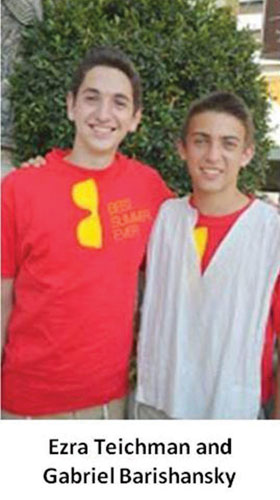.jpg)
When 1,000 teenagers agree on something the vibes are palpable. And loud. And all seemed to agree that Mini Israel near Latrun, about a half-hour from Jerusalem, was the perfect venue for this year’s Yom NCSY. All the teens are participants in summer programs designed to show Israel to teens from North America, and a miniaturized, though not-quite-to-scale, version of Israel was a reminder of what they had seen and done, felt and experienced.
But Yom NCSY was so much more. With hours of cheering, singing and dancing, the extravaganza, including a concert with Shlomo Katz and Gad Elbaz, was a reunion of what could be one of the world’s largest Jewish summer camps. It’s the one time during the summer when staff and participants of 11 different summer trips operated in Israel by the Orthodox Union are all in the same place at the same time.
Some of the teens had never been to Israel before. They came from 12 NCSY regions across the United States and Canada—from New York to California and all points in between, as well as Canada and a handful from Israel and Europe. Nearly half attend public schools and come from homes that are not religiously observant. Many others grew up with Jewish observance and attend a Jewish day school. Many of the participants received financial aid from the Orthodox Union or other sources.
But who cares? Certainly not the teens. Describing their Israel adventure as “awesome,” they reflected a feeling of unity. They talked about being inspired. They felt like they made friends for a lifetime. And most important, they connected to Israel. Each teen had a deep, personal experience filled with meaning and love of Judaism and Eretz Yisrael. And all seemed to agree with the sentiment expressed in the slogan of NCSY Summer programs: Best. Summer.Ever.
Gabriel Barishansky, 17, from Teaneck, NJ and Ezra Teichman, 16, from Monsey, NY were both on the Kollel program. “The learning here is very different from school,” Barishansky says. “We’re learning for the sake of learning—not for tests. That makes it a lot more enjoyable. It’s really pressure free.”
Ari Clark, 24, is from Teaneck, NJ. He is in his final year studying for semicha (rabbinic ordination) at Yeshiva University’s Rabbi Isaac Elchanan Theological Seminary. He was one of the directors on Lilly’s TJJ bus. “As a staff member what I’ll remember is that every kid has a story and comes from a very unique place,” he says. “It would be easy to think that we’ll take 35 kids and we’ll travel around the country and they’ll love it. But it’s not that way. Everyone internalizes and understands things in different ways.”
So what did they learn and what did they internalize?
Barishansky tells everyone “NCSY Kollel always hires the best madrichim (advisors). They’re older guys. They’re cool. They’re great at basketball. And they love learning. This program helped me a lot religiously. You can be frum and you can be cool.
“Even basketball is different here,” he says. “You learn to be good without being inappropriate. The language on the court here is a lot better than at home. My experience with the Kollel helped me appreciate my learning in school more.”
Barishansky also hiked up Har Shlomo in the Red Canyon near Eilat. “We started hiking up the mountain at 4:00 a.m. It was dark out. When we got to the top it was time to daven. We could put on our tefillin. The sun was just coming up over the desert mountains. It was an overall enjoyable experience with beautiful davening.”
Teichman who is with Barishansky at Kollel, was at the Kotel on Tisha b’Av. “We had a kumsitz and sang in the open area near the Kotel. It’s very inspiring and it’s cool because the entire Kollel goes. There are also people who happen to be in Israel and have heard about our kumsitz. It was my favorite part of the summer,” he says.
Staff member Ari Clark had a special experience at the Kotel. He calls it “The Blindfold Walk.”
The teens on his bus were all blindfolded. “The idea was that they should think about what they were about to see without seeing it right away,” he explains. “They weren’t just going to look at a wall. They were going to look at a part of their heritage—a treasure in the Jewish heart.”
Once they got near the Kotel they were told they could remove their blindfolds which most did. Several teens asked their friends to lead them down with their blindfolds still on.
“One of the boys on my bus had never seen the Kotel before,” Ari recalls. “His friends took him down and he put his hands on the stones. After a few minutes he took his blindfold off. Several minutes later he turned to walk away. He had tears in his eyes. Clearly he had been touched by something very special.
“We toured, we hiked, we saw so much,” Ari says. “But this is when they really opened their hearts to Judaism. They became part of the Jewish people.”
By Zvi Volk










